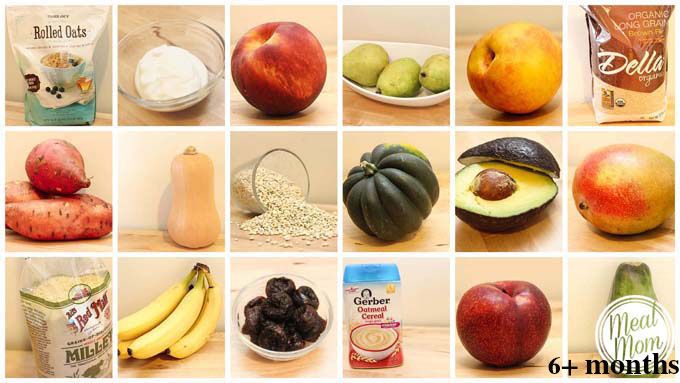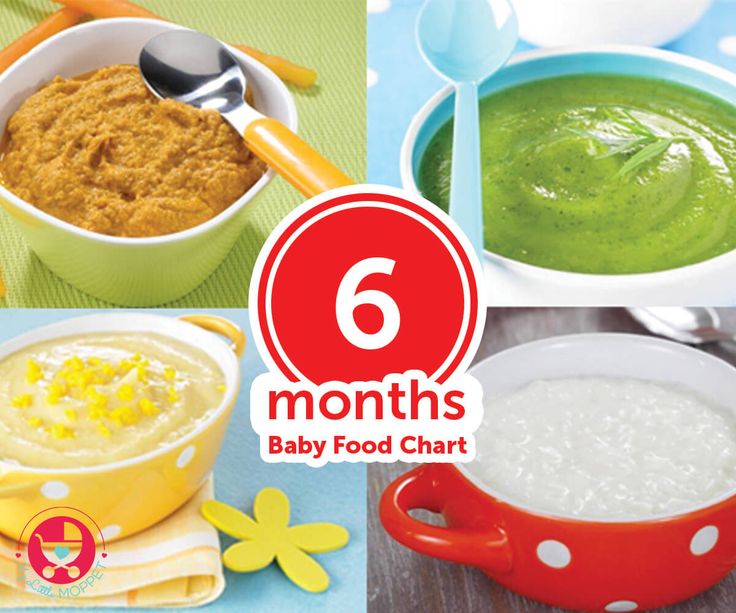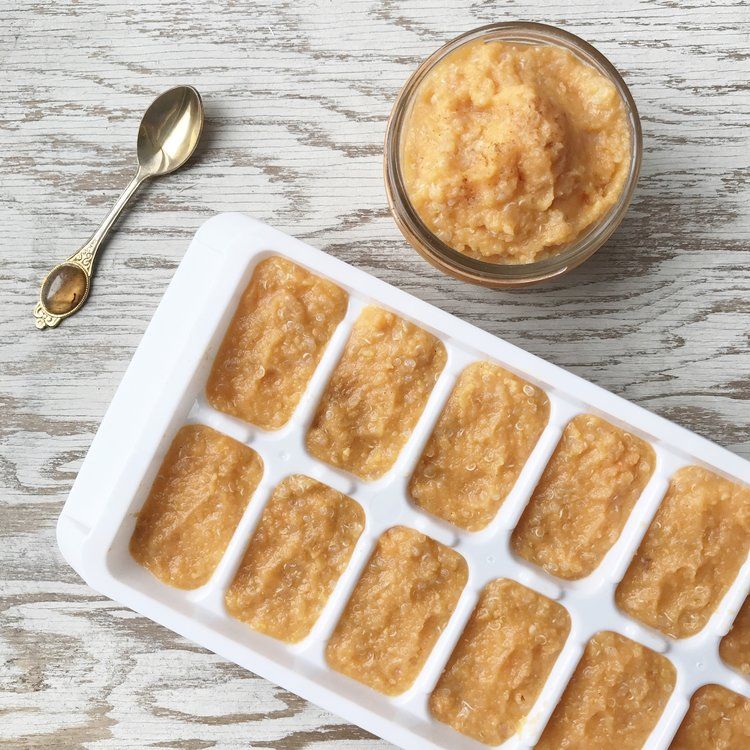Six month old baby food ideas
Baby Meal Plan: 6 to 9 Month Old
What should you know about feeding your 6- to 9-month-old?Learn about how to introduce solid foods to your baby
Know that what foods you introduce now help influence baby’s preferences in the future
Explore menus that help you understand the transition from purees to soft solids
Starting solid foods is an exciting time for you and your baby. The American Academy of Pediatrics and the World Health Organization recommend introducing solid foods around 6 months of age.1,2
Check out our signs of readiness article and speak with your baby’s pediatrician to help determine when your little one is ready to start solids.
While starting solids, you will continue to provide most of the essential nutrition and hydration your baby needs from breast milk or formula, while also exposing your baby to a new world of diverse flavors and nutrients.
In fact, this is one of the most influential periods in your baby’s taste development.3,4 Your baby will most readily try and accept all kinds of foods at this age so it’s important to offer a variety of different flavors from meal to meal.
There are two meal plans belowOne for starting solids with purees, and one for when your little one starts to advance textures. Both have snack and recipe ideas to help you get started. They also have plenty of flavor variety to help maximize your baby’s taste
development.
Read more: Learning to Love Healthy Foods
Pro tips for 6- to 9-month-old baby meal plansEating solids at this age is mostly about letting your baby explore new flavors and textures. Breast milk or formula will remain your baby’s primary nutrition source during their first year, so continue to give breast milk and/or formula just as you were before starting solids. Your little one will begin to reduce how much formula or breastmilk they take as they get closer to 1 year.5,67
Your little one will begin to reduce how much formula or breastmilk they take as they get closer to 1 year.5,67
For breastfed babies, introduction of solids at 6 months helps your little one get enough of certain nutrients. For example, at 6 months stored iron begins to diminish. Since breast milk is not a good source of iron, including some iron-rich foods, such as fortified cereals and pureed meats, will help your little one get enough.8
For more information, chat with baby’s health care provider for their recommendations.
For more information on the nutrient needs of your older baby, check out: Nutrient Needs and Feeding Tips for 6 to 12 Month Olds
How much should I feed my baby?At around 6 months old, you can start by offering 1 to 2 tablespoons of food once or twice per day. Once your little one gets the hang of eating and shows more interest, slowly begin offering foods 2 to 3 times per day and ¼ to ½ cup at a time. 9,10
9,10
Remember to listen to your baby’s hunger and fullness cues throughout their feeding journey, rather than go by specific portions. Your little may take more or less each day; by responding to their feeding cues you’ll be providing them with just what they need.11
It’s important to advance texture once your baby is comfortable. Start with thin, pureed foods, thickening them a bit as baby gets used to eating. Next, move to lumpy, mashed foods; followed by finely chopped, soft foods.12
Read more: Introducing Solids: First Foods & Textures
Introduce one single-ingredient new food at a timeAllow for 3 to 5 days before introducing another new food to make sure your baby is not allergic or intolerant to these foods. 9,12
Foods most often associated with allergies are eggs, soy, peanuts, tree nuts and seeds, wheat, fish, shellfish, and cow’s milk (drinking cow’s milk is not recommended before 12 months, but milk can be used in small amounts in baked or cooked foods, and baby can also eat yogurt and cheese as long as there is no allergy or intolerance). 13
13
Read more: Introducing Major Food Allergens to your Infant
What should baby eat by 9 months?By 9 months of age, your baby should be eating foods from all food groups, and should have been introduced to lumpy purees.15 Some little ones may be able to handle small, soft pieces of finger foods by this age as well.
Pay attention to your baby’s cues, have fun, and let your baby set the pace while offering your baby healthy foods that contain important nutrients to set the standard for healthy eating patterns.
Baby doesn’t like a food? Try, try again!Your baby may grimace, wrinkle their nose, or make other faces when they try new foods and textures. Know that this is completely normal and doesn’t mean your little one dislikes the food or is being picky.
Babies may need to taste a food up to 10 or more times before they start to accept it, so just keep offering (though not forcing) that food. 14
14
Remember, starting solids is mostly about introducing a variety of flavors and textures – and keeping it fun and stress-free!
If you have questions about introducing solids or advancing textures, reach out to our team of registered dietitian nutritionists for free! They are here to help on our free live chat from Monday through Friday, from 8am–6pm ET. Chat now!
Around 6-month old meal plan: First foods and pureesBreakfast
Option 1: Whole Ancient Grain Baby Cereal
Option 2: Mashed avocado
Option 3: Avocado and Pea Puree
Option 4: Apple and acorn squash mash (pureed apples and squash mixed)
Option 5: Pureed peaches or soft cooked pears
Option 1: Root Vegetable Puree
Option 2: Unsweetened whole milk yogurt
Option 3: Avocado and Pea Puree
Option 4: Pureed apples
Option 5: Quinoa cereal
Option 1: Mashed “Banacado” (banana and avocado mashed together)
Option 2: Baby Muesli with Peach Yogurt
Option 3: Tropical medley (mashed papaya and mango)
Option 4: Garden veggie and fruit combo (mix mashed/pureed apples, spinach and peas)
Option 5: Beet and Cantaloupe Puree
Option 1: Unsweetened yogurt with mashed peaches
Option 2: Oatmeal cereal
Option 3: Whole grain waffle strips
Option 4: Orange Sunny Soup
Option 5: Soft scrambled egg
Option 1: Soft cooked whole grain pasta with olive oil and parmesan cheese
Option 2: Slivers of turkey with peas
Option 3: Unsweetened applesauce and shredded or cubed cheese
Option 4: Chickpea and Carrot Spread
Option 5: Cottage Cheese with Cinnamon and Diced Strawberries
Option 1: Soft cooked slivers of chicken, with steamed carrots
Option 2: Ginger Carrot & Sweet Potato Mash + Lean Beef
Option 3: Small chunks of low mercury fish, like cod
Option 4: Soft steamed chunks of broccoli or green beans
Option 5: Lumpy, mashed kidney or black beans
We know parenting often means sleepless nights, stressful days, and countless questions and confusion, and we want to support you in your feeding journey and beyond.
Our Happy Baby Experts are a team of lactation consultants and registered dietitian nutritionists certified in infant and maternal nutrition – and they’re all moms, too, which means they’ve been there and seen that. They’re here to help on our free, live chat platform Monday - Friday 8am-6pm (ET). Chat Now!
Read more about the experts that help write our content!
For more on this topic, check out the following articles and recipes:Starting Solids: Purees versus Baby Led Weaning
Starting Solids: Baby Led Weaning
The Division of Responsibility: Helping Avoid Picky Eating
Feeding Tips for Healthy Weight Gain in Babies and Toddlers
Our meal plans offer recipe and meal suggestions for your child. They are not designed to replace your doctor’s recommendations, nor do they take into account special nutritional needs, including allergies and intolerances. The meal plans suggest serving sizes that may or may not be appropriate for your child. Please consult your doctor to determine what is best for your child.
Please consult your doctor to determine what is best for your child.
6-Month Baby Food Ideas Every Mom Needs to Know
279photo Studio/Shutterstock
Mealtime is such a fun part of the day for you and Baby. We've got all the details on what to feed your 6-month-old, plus plenty of tips.
It’s so exciting when your baby becomes curious about food. She grabs at your plate and silverware—making it nearly impossible for you to eat your own meal! Typically, this behavior begins around the six-month mark. And at this point, it’s time for you to start experimenting with solid foods.
Interested in baby-led weaning? Here’s what to expect.
When should I start feeding my baby solid foods?
Before you begin solid foods, ensure that your baby can hold his head up and sit upright in a high chair. Always supervise your baby during mealtimes.
In addition to breast milk and formula, you can begin offering your baby many different foods as you start sharing mealtime together.
Find more info on when you should start with solid food here.
What should my 6-month-old eat?
Some of the first foods offered to babies are brown rice cereal and oatmeal. These bland options allow your baby to practice using a spoon and discover how her tongue works.
Start by introducing dry cereal or grain puffs during mealtime, and let your baby feed herself.
Once your baby is comfortable with cereal, offer:
- Cheese
- Beans
- Muffins
- Pureed or strained fruits (banana, pears, applesauce, peaches, avocado)
- Pureed or strained vegetables (well-cooked carrots, squash, sweet potato)
- Pureed protein (chicken, pork, beef, tofu or fish)
- Small amounts of unsweetened yogurt (Keep in mind your baby should not have cow’s milk until he is at least one year old.
 )
) - Scrambled eggs (Here’s why eggs are a good option!)
- Pasta
Learn more about the foods you should (and shouldn’t!) start your baby on.
How much should my baby be eating?
Babies around six months of age will eat approximately 6-12 ounces of pureed baby food per day. (Here’s how to make baby food at home). But the exact amount depends on your child.
Bonus: 6-month baby food meal plan
No, meal planning isn’t just for adults. We’ve laid out a super simple meal plan for you to follow with your baby.
You’ll want to continue offering your baby breast milk or formula as needed, then start to add in solid foods at breakfast, lunch and dinner.
- Breakfast: Rice cereal or oatmeal
- Lunch: Pureed fruits and/or veggies
- Dinner: Pureed meats and veggies
Psst! You should avoid these foods when breastfeeding.
Popular Videos
ⓘ
Originally Published: May 07, 2019
Kristin George
Kristin George is a lifestyle + parenting writer and content creator living in Milwaukee, WI, with her husband and three boys. She is the founder of Dotted Comma, a marketing consulting agency driven to "cause a pause." In addition to her family and writing, she loves coffee, yoga, traveling, and making lists. You can connect with Kristin at dottedcomma.com.
diet for a 6-month-old baby with breast and artificial feeding, an approximate menu for a week in the table, a diet for a day
Published: 02/10/2021
Reading time: 4 min.
Number of reads: 230756
Author of the article: Ponomareva Yuliya Vladimirovna
Pediatrician, candidate of medical sciences, allergist-immunologist
Changes in a child in the first year of life are very rapid, and each month is not like another. The 6-month milestone is very important, it is largely evaluative and transitional. By this age, most babies have doubled their birth weight, are about 15 cm tall, and some babies have already erupted their teeth. The age of 6 months is also transitional in terms of nutrition. Breast milk or an adapted formula is still the basis of the diet, but with the beginning of the second half of life, all children, without exception, should begin to receive complementary foods. Despite the general graph of growth and weight gain and indicators of psychomotor development, the status and diet of children at 6 months can be very different.
By this age, most babies have doubled their birth weight, are about 15 cm tall, and some babies have already erupted their teeth. The age of 6 months is also transitional in terms of nutrition. Breast milk or an adapted formula is still the basis of the diet, but with the beginning of the second half of life, all children, without exception, should begin to receive complementary foods. Despite the general graph of growth and weight gain and indicators of psychomotor development, the status and diet of children at 6 months can be very different.
Content: Hide
- The first feeding of 6 months
- The start of complementary foods in 4-5 months
- The second half of life
- for a week for a child at 6 months
The first lure of 6 months
If the baby is healthy and breastfed, and his mother eats a full and varied diet, exclusive breastfeeding is possible until this age. Cereal complementary foods in this case are preferable to start. This is due to the high energy and nutritional value of cereals, the ability to significantly enrich the baby's diet with a delayed start of the introduction of complementary foods.
This is due to the high energy and nutritional value of cereals, the ability to significantly enrich the baby's diet with a delayed start of the introduction of complementary foods.
However, the rate of expansion of the child's diet in this situation will be accelerated. Before the 8th month of life, it is necessary to introduce all basic food groups into the baby’s menu, since in the second half of the year the need for additional intake of nutrients and micronutrients is very high. Another reason explaining the importance of the rapid introduction of complementary foods is the formation of immunity of the immune cells of the intestine to ordinary food. If a child is introduced to these foods at the age of 4-8 months, the risk of developing food allergies has been proven to be reduced.
Complementary feeding starts at 4-5 months
In today's life, the nutrition of a nursing mother, unfortunately, is not always complete. Therefore, for most breastfed babies, complementary foods already need to be introduced from 5 months in order to prevent deficient conditions.
If a child is bottle-fed, then by the 4th month of life, the baby will not have enough adapted formula alone, and in this group of children, the timing of the introduction of complementary foods usually shifts a month earlier than in breast-fed babies. Accordingly, by 6 months, children will have vegetable puree and gluten-free porridge (buckwheat, corn and rice) in their diet. In the first half of life, monocomponent meals are used (that is, from one type of grain and vegetables), prepared on the basis of water, breast milk or an adapted mixture.
Fruit puree and juice can be another possible complementary food for children under 6 months of age without allergy symptoms. In a child with a risk of developing or manifesting allergies, the timing of the introduction of fruit complementary foods is shifted to the 8th month.
Second six months of life
Children over 6 months of age can supplement their diet with cereals containing gluten. First of all, these are oatmeal and wheat porridge, and then multi-cereal dishes with the addition of other cereals (millet, barley, rye). If the child does not have any manifestations of allergies, milk porridge can be included in the menu at this age. Bebi Premium industrial baby food products include specially prepared milk that is safe to use in healthy babies in the first year of life.
If the child does not have any manifestations of allergies, milk porridge can be included in the menu at this age. Bebi Premium industrial baby food products include specially prepared milk that is safe to use in healthy babies in the first year of life.
From the age of 6 months, the baby's diet is expanded with such important products as meat and cottage cheese. These products are a source of high-quality protein, fats, and are also rich in minerals such as iron, calcium, and phosphorus. Pediatricians and nutritionists recommend introducing meat and cottage cheese as part of combined dishes based on a fruit and vegetable and / or grain component in a ratio of 1 (cottage cheese / meat): 4–5 (fruits / vegetables / cereals).
To enrich the diet with polyunsaturated fatty acids in the second half of the year, the menu includes vegetable oil in the amount of 3–5 grams per day, which can be added to the complementary food dish. The volume of each feeding is approximately 150-170 ml, and the child can already stand up to 3. 5 hours between meals.
5 hours between meals.
In the table below, we offer a menu of 6 months for a week for a child who started receiving complementary foods at the age of 4-5 months, and by the time the second half of life begins, dairy-free gluten-free cereals, vegetable and fruit purees have already been introduced into his diet.
1st day
| Meeting | menu | ml/g |
| Breast milk/mixture | 150 | 50 |
| Lunch (12.30) | Vegetable soup with beef, olive oil | 100/30/3 | 9 9006 900 66 9 |
| Afternoon snack (16.00) | Plum puree with cottage cheese | 60/40 |
| Breast milk/formula | 60 066 | |
| Lunch (12.30) | soup puree made of cauliflower and broccoli, olive oil | 80/3 |
| souffle from meat of rabbits | ||
Afternoon snack (16. 00) 00) | Milk porridge “Delicious afternoon snack with Bebi Premium biscuits and pears” | 100 | 9007 1
| food intake | menu | ml/g |
| Early morning | breast milk/mixture | 150 | COMLACE (09) cherry Bebi Premium» | 100 |
| 0065 Breast milk/mixture | 150 | |
| children's soluble cookies "BEBIKI" Classic | ||
| Bebi Premium Kids Instant Herbal Tea | 50 | |
| Bedtime 065 Breast milk/formula | 150 | |
Rate the article
(Number of votes: 23, average 4.8)
Share with friends:
From 4 to 6 months
Breast milk is the best food for your baby.
It is very important that the baby consumes breast milk for as long as possible.
The right age to start complementary foods
It is recommended to start introducing complementary foods into the baby's diet no earlier than 4 months, but no later than 6 months*. At this age, the baby is in the active phase of development and reacts with curiosity to everything new! Some babies at 4 to 5 months of age can no longer satisfy their appetite with breast milk alone and need complementary foods for healthy growth. Other children have enough breast milk, and they are ready for the introduction of complementary foods only after 6 months. The decision to start complementary foods should always be made according to your baby's development. Do you feel like your baby is not getting enough breast milk? Does your baby hold his head on his own, show interest in new foods or a spoon? Then it's time to start feeding. If in doubt, consult your pediatrician.
If your baby spits out the first spoonfuls of puree, be patient. After all, he must first learn to swallow it. Start with a few scoops and give your child time to get used to the new form of feeding.
After all, he must first learn to swallow it. Start with a few scoops and give your child time to get used to the new form of feeding.
*Recommendation of the Nutrition Committee of the European Society of Pediatric Gastroenterology, Hepatology and Nutrition (ESPGHAN)
Why is complementary food so important for the baby?
After 4-6 months of life, mother's milk or milk formula alone is not enough to supply the child's body with all the nutrients and energy it needs. In addition, the transition to solid food trains the muscles of the mouth. And finally, with the introduction of complementary foods, the child will get acquainted with the variety of taste directions, which is also important for his development.
When to start complementary foods?
Gradually replace one breastfeed with complementary foods. First for lunch, then for dinner and finally for lunch. The mouse eats breakfast with the usual dairy food.
Starting complementary foods with HiPP products is easy. The first spoons will be vegetable or fruit purees HiPP:
The first spoons will be vegetable or fruit purees HiPP:
First step: lunch
We recommend that you start complementary foods at lunchtime with HiPP vegetable puree (for example, "Zucchini. My first puree", "Cauliflower. My first puree" or "Broccoli .My first puree"). Then, for satiety, feed your baby as always: breast or bottle. The amount of vegetable puree can be increased daily by 1 spoon. Be patient if your baby does not immediately love vegetables. Try repeating the vegetable puree in the following days. Next week, you can expand your diet with other varieties of HiPP vegetables (for example, "Carrots. My first puree" or "Potatoes. My first puree").
If your baby tolerates vegetables well, in the third week you can introduce grain porridge into the diet, and as a dessert, offer a few spoons of fruit puree enriched with vitamin C. Vitamin C helps to better absorb iron in the body.
Once your baby starts eating a whole serving of mashed potatoes for lunch, you can eliminate breast milk or formula during that meal.











